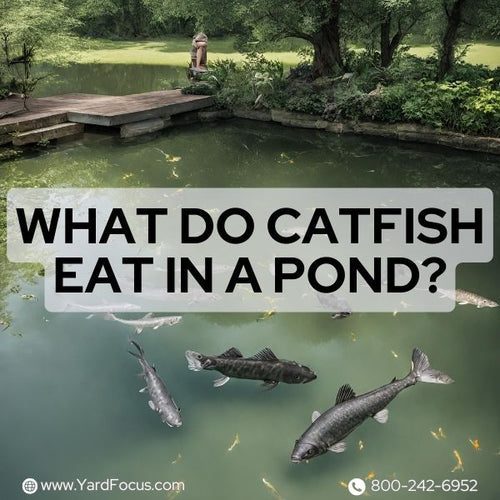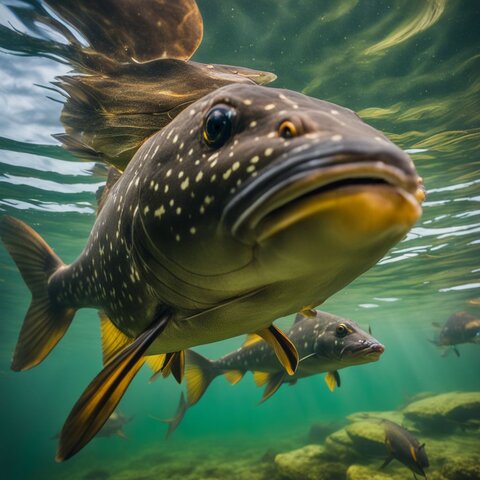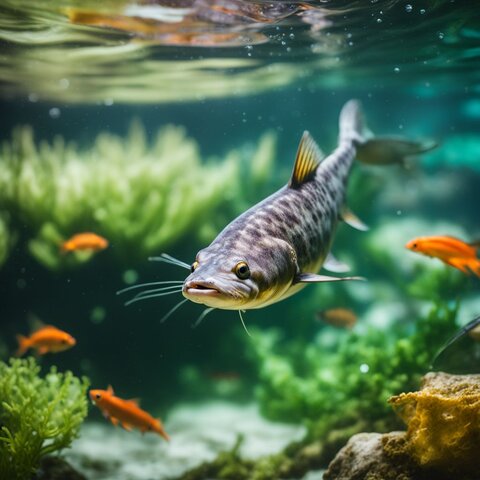
What Do Catfish Eat In A Pond?
Many people wonder what do catfish eat in a pond. The diet of a catfish can vary greatly, including everything from small fish to plant matter.
This blog will explore the diverse menu that keeps these bottom dwellers thriving in ponds across various environments.
Stay tuned to uncover a catfish's diet.
Understanding The Catfish Diet
Jumping from a general introduction to the specific eating habits of catfish, it's fascinating how adaptable these fish are.
Catfish's diet is remarkably diverse, reflecting their opportunistic feeding behavior.

They consume both meat and plants, showing a preference for bottom feeding but also surfacing when the opportunity arises.
This flexibility allows them to thrive in many environments by feeding on live prey like small fish or insects, scavenging dead animals, and even munching on some plant material.
Their powerful sensory organs help them locate food in murky waters where visibility is low.
Whether they're after bluegills in a pond or scavenging for decaying matter along the bottom, catfish use their keen sense of smell and taste to navigate their meals.
This ability ensures they rarely miss out on a potential feast and can continue growing and thriving across different habitats.
Different Species of Catfish and Their Diets
Catfish come in various types, each with its own favorite foods. From insects to other fish, their diets can vary widely based on the species.

Flathead Catfish
Flathead catfish predominantly prey on live fish, distinguishing them for their active hunting behavior.
Flathead catfish distinctively pursue live fish over plants or sedentary prey, showcasing their preference for hunting.
They look for prey like sunfish, shad, and even other smaller catfish to chow down on.
This active hunting behavior positions flathead catfish as significant predators within their aquatic ecosystems, constantly in search of prey.
Flathead catfish demonstrate a marked preference for live prey, showing less interest in plant-based materials or artificial feed.
Anglers looking to catch flatheads use this knowledge to their advantage by using live baits such as small fish or worms.
This predatory nature shapes how people fish for them and manage the ponds where they live.
Next up is the Blue Catfish discussion.
Blue Catfish
Blue catfish have a big appetite for bait fish like shad, bluegill, mooneye, and skipjack.
They hunt these smaller fish in ponds using their keen sense of smell. Besides chasing after live prey, they also munch on freshwater mussels, clams, and snails.
These items not only make up a large part of their diet but also serve as bait for anglers looking to catch them.
Being bottom feeders by nature, blue catfish scavenge for food along the pond's floor.
Their diet shows how adaptive and carnivorous they are while contributing to their status as top predators in their habitat.
This feeding behavior helps control the population of nonnative species and maintains a healthy ecosystem in the pond.
Channel Catfish
Channel catfish have a diverse diet that helps them thrive in pond environments.
They eagerly feed on live worms, salamanders, maggots, leeches, caterpillars, insects, frogs, fish such as shellcrackers, and even invasive species like bowfin.
Mussels and crayfish also make up a significant part of their diet. Unlike some other fish, they rarely eat plants.
Their ability to use a keen sense of smell guides them to food sources ranging from the bottom mud to surface water.
Introducing pellet feed into ponds where channel catfish live can promote faster growth.
This type of fish feed is less costly than live bait yet highly effective due to their omnivorous nature and flexibility in diet adaptation.
Next up is bullhead catfish.
Bullhead Catfish
Bullhead catfish, embodying their omnivorous nature, consume a varied diet, including aquatic vegetation, insects, fish eggs, and snails.
These catfish aren't picky. They will eat almost anything they can find in a pond.
The bullhead catfish's diet is varied, encompassing small fish, insects, and detritus, highlighting their adaptability.
These creatures easily adapt their eating habits to survive in different places, including rivers and still waters.
This ability makes bullheads efficient scavengers in various environments.
By consuming detritus and dead organic matter, bullhead catfish contribute to the ecological balance and water quality of their habitats.
What Catfish Eat in Different Water Bodies
Catfish change their diet based on where they live, like ponds, rivers, or lakes. This means they eat different things in each place to stay healthy and grow.

Ponds
Ponds offer an ideal setting for catfish because of their calm waters and abundant food sources.
These fish use their keen sense of smell to find insects, snails, vegetation, and other smaller fish to eat.
Conditions in ponds support a rich diet that helps catfish grow large and healthy.
Water temperature plays a crucial role in how much they feed, since they are cold-blooded animals.
In warm water, catfish exhibit increased metabolic rates, leading to more active foraging behavior.
In these environments, catfish also respond well to live or cut bait, making them a prime target for anglers.
Since ponds can vary greatly in terms of size and the types of life they support, the diet of pond-dwelling catfish can be quite diverse.
Anglers often use baits like worms or small pieces of fish to attract them during fishing trips.
This variety ensures that catfish have access to enough nutrition throughout different seasons and water conditions.
Rivers
Rivers offer a dynamic environment for catfish, influencing their diet significantly.
These water bodies are home to flatheads, blue catfish, channel catfish, and bullhead catfish, each with its own unique feeding habits.
In river settings, the strong current affects the availability of prey. Catfish adapt by hunting for food that thrives in these moving waters.
They consume a variety of creatures, such as smaller fish, insects, and aquatic plants.
The predator-prey relationship plays a crucial role in their diet here.
In rivers, catfish often seek out areas where water movement is slower to catch their prey easier.
Places like bends in the river or where debris has accumulated make perfect spots for them to feed.
During spawning seasons or when fish kill events occur due to low oxygen levels or pollution, catfish might change their diet to include dead or dying fish found in abundance during such times.
This adaptability ensures they continue thriving in fluctuating river conditions.
Lakes
Moving from rivers to lakes, catfish continue their versatile feeding habits. Lakes offer a diverse menu for catfish, including small fish, insects, and aquatic plants.
They use their keen sense of smell to locate food in the often larger and deeper environments of lakes.
Catfish in lakes might also feed on dead matter that sinks to the bottom, making them important players in the ecosystem by helping with decomposition.
In these calm waters, seasonal changes and available forage greatly influence what catfish eat.
During warmer months, they might be more active hunters, seeking out live prey. In colder temperatures, they rely more on whatever food is available at the lake's bottom.
This adaptability helps catfish thrive in various aquatic environments.
The Influence of Water Temperature on Catfish Diet
Water temperature plays a big role in what catfish eat. As the water gets warmer, catfish become more active and hungry because their metabolism speeds up.
They start to feed more often and look for different kinds of food.

In colder water, however, catfish slow down and don't eat as much. This means they might not go after the usual baits or foods that fishermen use.
In the warmth of summer, pond catfish often pursue smaller fish and insects, attracted by their abundance and ease of capture.
During cooler months, they may rely more on consuming detritus and other organic matter from the pond bed, as these resources require less energy to locate.
Each season changes what's available for them to eat in ponds, making understanding water temperature key for anyone trying to figure out a catfish's diet.
Top Baits and Lures for Attracting Catfish in Ponds
Catfish in ponds love to eat a variety of foods. Choosing the right bait or lure can help you catch them easily.
Here are some top baits and lures that work great for attracting catfish in ponds:
- Nightcrawlers: Bullhead catfish find these irresistible. A worm on your hook is often all it takes to attract their attention.
- Stink Baits: Channel catfish have a keen sense of smell. Baits that smell strong will often lure them in. You can find these smelly options at your local feed store.
- Live Bait: Flathead catfish prefer chasing live prey. Small fish or insects can be very effective drawing them out.
- Cut Bait: Pieces of fish make excellent bait for larger species like the blue and flathead catfish. The scent attracts them from afar.
- Cheese Baits: These work well for several types of pond catfish, especially if they're used to human-provided foods.
- Commercial Lures: Some lures are designed to mimic the look and movement of catfish prey, such as small fish or insects, making them a good choice for more experienced anglers looking to catch Ictalurus punctatus and other species.
- Chicken Liver: This is another strong-smelling option that works well for attracting many kinds of catfish, offering high feed conversion rates similar to what they'd find naturally.
By using these baits and lures, you can increase your chances of catching catfish in a pond significantly.
Always check what's available at your nearest feed store and experiment with different options to see what works best in your local waters.
FAQs
What do flathead catfish like to eat in a pond?
Flathead catfish enjoy eating smaller fish, insects, and sometimes plants found in the pond.
Can catfish eat things other than fish in a pond?
Yes, besides small fish, catfish can also munch on bugs, plants, and almost anything they find tasty in the water.
Do hardhead catfish have a different diet from other types of catfish?
Though not specifically mentioned in the main content, hardhead catfish, like other catfish species, have a varied diet primarily consisting of small fish, crustaceans, and mollusks, with no specific preference for 'harder-to-chew' meals despite their name.
Have people ever seen a catfish puke up its food?
While it's not common to see, if a catfish eats too much or something it doesn't like, it might puke just like other animals.
Conclusion
Are you wondering what do catfish eat in a pond? Catfish in ponds enjoy a versatile diet that keeps them healthy and growing.
These fish are not picky eaters. They happily munch on insects, small fish, plants, and even dead animals they find in the water.
Since food sources can vary from one pond to another, catfish adapt by eating what's available.
This ability to adjust their diet means they thrive in many different environments, making ponds an ideal home for them.
So if you're fishing or just observing, know that these fascinating creatures have quite the varied menu underwater.

